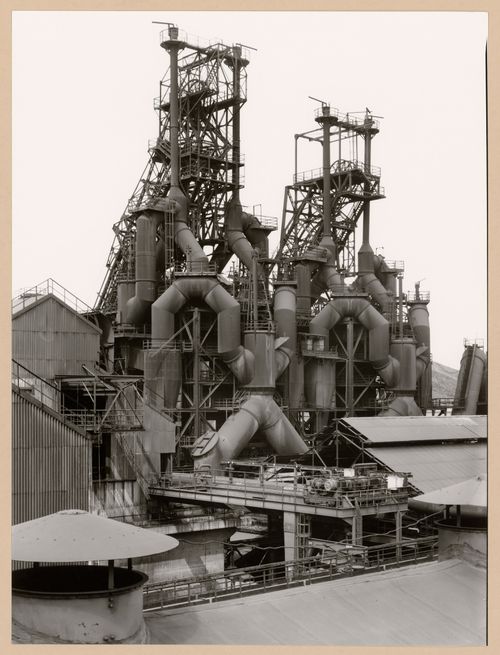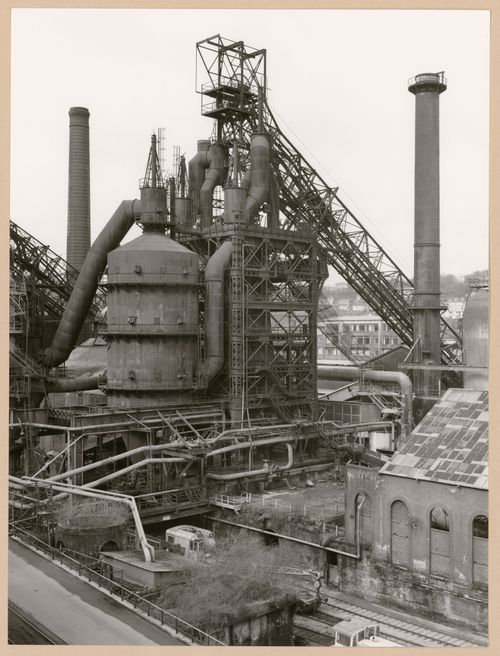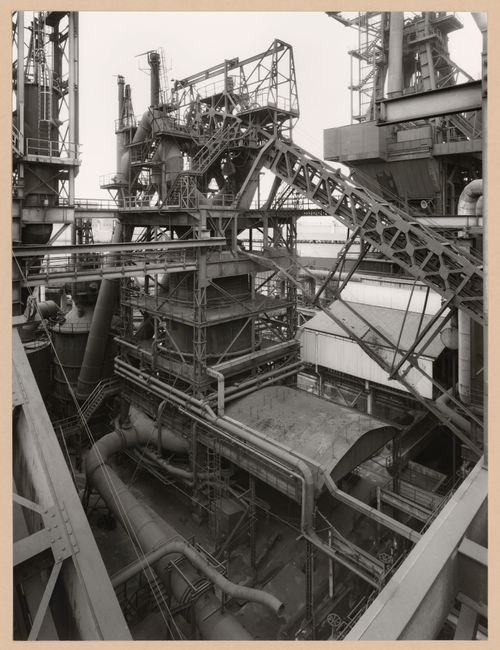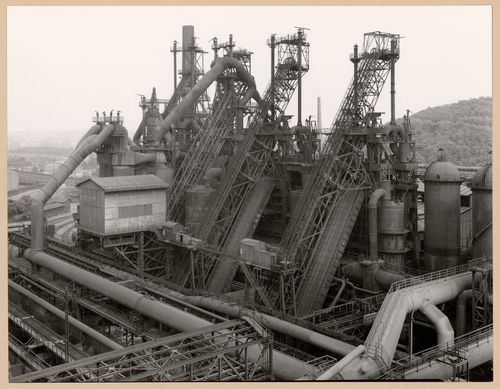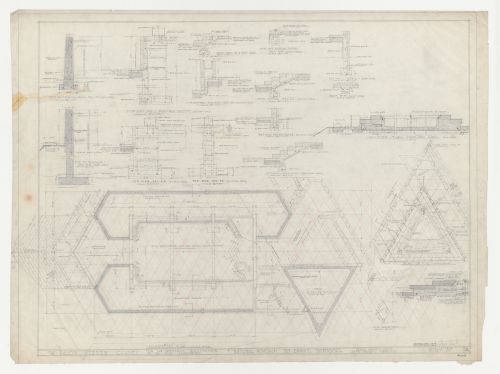View of a blast furnace of Hainaut-Sambre steel mill, Montignies-sur-Sambre, Charleroi, Belgium
PH1987:1049
Description:
- The group of 86 photographs PH1987:0996 - PH1987:1081 by Bernd and Hilla Becher show 75 views of steel mill blast furnaces and 11 views of mines. There are 45 views of steel mill blast furnaces in Germany, 15 in the United States, and five in each of France, Luxembourg and Belgium. There are five views of mines in Germany, two in Belgium, two in the United States, and one in each of France and Wales. - The group of 86 photographs PH1987:0996 - PH1987:1081 by Bernd and Hilla Becher show five views of steel mill blast furnaces in Belgium including: two views of the Cockerill steel mill in Ougrée (PH1987:1048 and PH1987:1063); two views of the Hainaut-Sambre steel mill in Montignies-sur-Sambre (PH1987:1049 and PH1987:1064); and one view of the Boel Steel Plant in La Louvière (PH1987:1053). - The photographers indicate that the group of six photographs PH1987:1048 - PH1987:1053 of views of blast furnaces should be exhibited in two rows arranged from left to right and top to bottom in numerical order according to the photographers' inscriptions "M 1" through "M 6",. Photograph PH1987:1048 would therefore be at the far left of the upper row, while photograph PH1987:1053 would be at the far right of the bottom row (Kicken Pauseback, 1987).
architecture, ingénierie
1984
View of a blast furnace of Hainaut-Sambre steel mill, Montignies-sur-Sambre, Charleroi, Belgium
Actions:
PH1987:1049
Description:
- The group of 86 photographs PH1987:0996 - PH1987:1081 by Bernd and Hilla Becher show 75 views of steel mill blast furnaces and 11 views of mines. There are 45 views of steel mill blast furnaces in Germany, 15 in the United States, and five in each of France, Luxembourg and Belgium. There are five views of mines in Germany, two in Belgium, two in the United States, and one in each of France and Wales. - The group of 86 photographs PH1987:0996 - PH1987:1081 by Bernd and Hilla Becher show five views of steel mill blast furnaces in Belgium including: two views of the Cockerill steel mill in Ougrée (PH1987:1048 and PH1987:1063); two views of the Hainaut-Sambre steel mill in Montignies-sur-Sambre (PH1987:1049 and PH1987:1064); and one view of the Boel Steel Plant in La Louvière (PH1987:1053). - The photographers indicate that the group of six photographs PH1987:1048 - PH1987:1053 of views of blast furnaces should be exhibited in two rows arranged from left to right and top to bottom in numerical order according to the photographers' inscriptions "M 1" through "M 6",. Photograph PH1987:1048 would therefore be at the far left of the upper row, while photograph PH1987:1053 would be at the far right of the bottom row (Kicken Pauseback, 1987).
architecture, ingénierie
PH1987:1052
Description:
- The group of 86 photographs PH1987:0996 - PH1987:1081 by Bernd and Hilla Becher show 75 views of steel mill blast furnaces and 11 views of mines. There are 45 views of steel mill blast furnaces in Germany, 15 in the United States, and five in each of France, Luxembourg and Belgium. There are five views of mines in Germany, two in Belgium, two in the United States, and one in each of France and Wales. - The group of 86 photographs PH1987:0996 - PH1987:1081 by Bernd and Hilla Becher show five views of steel mill blast furnaces located in the Lorraine region of France including: two views of the Sacilor-Sollac steel mill in Rombas (PH1987:1035 and PH1987:1068); two views of the Usinor-Senelle steel mill in Longwy-Bas (PH1987:1052 and PH1987:1069); and one view of a steel mill in Neuves-Maisons (PH1987:1067). - The photographers indicate that the group of six photographs PH1987:1048 - PH1987:1053 of views of blast furnaces should be exhibited in two rows arranged from left to right and top to bottom in numerical order according to the photographers' inscriptions "M 1" through "M 6",. Photograph PH1987:1048 would therefore be at the far left of the upper row, while photograph PH1987:1053 would be at the far right of the bottom row (Kicken Pauseback, 1987).
architecture, ingénierie
1985
View of a blast furnace of Usinor-Senelle steel mill, Longwy-Bas, Lorraine, France
Actions:
PH1987:1052
Description:
- The group of 86 photographs PH1987:0996 - PH1987:1081 by Bernd and Hilla Becher show 75 views of steel mill blast furnaces and 11 views of mines. There are 45 views of steel mill blast furnaces in Germany, 15 in the United States, and five in each of France, Luxembourg and Belgium. There are five views of mines in Germany, two in Belgium, two in the United States, and one in each of France and Wales. - The group of 86 photographs PH1987:0996 - PH1987:1081 by Bernd and Hilla Becher show five views of steel mill blast furnaces located in the Lorraine region of France including: two views of the Sacilor-Sollac steel mill in Rombas (PH1987:1035 and PH1987:1068); two views of the Usinor-Senelle steel mill in Longwy-Bas (PH1987:1052 and PH1987:1069); and one view of a steel mill in Neuves-Maisons (PH1987:1067). - The photographers indicate that the group of six photographs PH1987:1048 - PH1987:1053 of views of blast furnaces should be exhibited in two rows arranged from left to right and top to bottom in numerical order according to the photographers' inscriptions "M 1" through "M 6",. Photograph PH1987:1048 would therefore be at the far left of the upper row, while photograph PH1987:1053 would be at the far right of the bottom row (Kicken Pauseback, 1987).
architecture, ingénierie
PH1987:1053
Description:
- The group of 86 photographs PH1987:0996 - PH1987:1081 by Bernd and Hilla Becher show 75 views of steel mill blast furnaces and 11 views of mines. There are 45 views of steel mill blast furnaces in Germany, 15 in the United States, and five in each of France, Luxembourg and Belgium. There are five views of mines in Germany, two in Belgium, two in the United States, and one in each of France and Wales. - The group of 86 photographs PH1987:0996 - PH1987:1081 by Bernd and Hilla Becher show five views of steel mill blast furnaces in Belgium including: two views of the Cockerill steel mill in Ougrée (PH1987:1048 and PH1987:1063); two views of the Hainaut-Sambre steel mill in Montignies-sur-Sambre (PH1987:1049 and PH1987:1064); and one view of the Boel Steel Plant in La Louvière (PH1987:1053). - The photographers indicate that the group of six photographs PH1987:1048 - PH1987:1053 of views of blast furnaces should be exhibited in two rows arranged from left to right and top to bottom in numerical order according to the photographers' inscriptions "M 1" through "M 6",. Photograph PH1987:1048 would therefore be at the far left of the upper row, while photograph PH1987:1053 would be at the far right of the bottom row (Kicken Pauseback, 1987).
architecture, ingénierie
1985
View of a blast furnace of Boel Steel Plant, La Louvière, Belgium
Actions:
PH1987:1053
Description:
- The group of 86 photographs PH1987:0996 - PH1987:1081 by Bernd and Hilla Becher show 75 views of steel mill blast furnaces and 11 views of mines. There are 45 views of steel mill blast furnaces in Germany, 15 in the United States, and five in each of France, Luxembourg and Belgium. There are five views of mines in Germany, two in Belgium, two in the United States, and one in each of France and Wales. - The group of 86 photographs PH1987:0996 - PH1987:1081 by Bernd and Hilla Becher show five views of steel mill blast furnaces in Belgium including: two views of the Cockerill steel mill in Ougrée (PH1987:1048 and PH1987:1063); two views of the Hainaut-Sambre steel mill in Montignies-sur-Sambre (PH1987:1049 and PH1987:1064); and one view of the Boel Steel Plant in La Louvière (PH1987:1053). - The photographers indicate that the group of six photographs PH1987:1048 - PH1987:1053 of views of blast furnaces should be exhibited in two rows arranged from left to right and top to bottom in numerical order according to the photographers' inscriptions "M 1" through "M 6",. Photograph PH1987:1048 would therefore be at the far left of the upper row, while photograph PH1987:1053 would be at the far right of the bottom row (Kicken Pauseback, 1987).
architecture, ingénierie
PH1987:1070
Description:
- The group of 86 photographs PH1987:0996 - PH1987:1081 by Bernd and Hilla Becher show 75 views of steel mill blast furnaces and 11 views of mines. There are 45 views of steel mill blast furnaces in Germany, 15 in the United States, and five in each of France, Luxembourg and Belgium. There are five views of mines in Germany, two in Belgium, two in the United States, and one in each of France and Wales. - The group of 86 photographs PH1987:0996 - PH1987:1081 by Bernd and Hilla Becher show 45 views of steel mill blast furnaces in Germany including: 36 views of three blast furnaces of the Metallhüttenwerk in Lübeck-Herrenwyk (PH1987:0996 - PH1987:1031); three views of the Thyssen Hütte steel mill in Ruhrort, Duisburg (PH1987:1033, PH1987:1043 and PH1987:1050); two views of the Gute-Hoffnungs-Hütte steel mill in Oberhausen, Ruhr (PH1987:1044 and PH1987:1070); and one view each of the Klöckner Werke steel mill in Haspe (PH1987:1032), the Schalker Verein steel mill in Gelsenkirchen, Ruhr (PH1987:1042), the Ilseder Hütte steel mill in Ilsede (PH1987:1034) and the Hainer Hütte steel mill in Siegen (PH1987:1045). - The photographers have not indicated the exhibition layout for the group of eleven photographs PH1987:1060 - PH1987:1070 of views of blast furnace "landscapes" which are numbered from "P 1" through "P 11" (Kicken Pauseback, 1987).
architecture, ingénierie
1969
View of Gute-Hoffnungs-Hütte steel mill, Oberhausen, Ruhr, Germany
Actions:
PH1987:1070
Description:
- The group of 86 photographs PH1987:0996 - PH1987:1081 by Bernd and Hilla Becher show 75 views of steel mill blast furnaces and 11 views of mines. There are 45 views of steel mill blast furnaces in Germany, 15 in the United States, and five in each of France, Luxembourg and Belgium. There are five views of mines in Germany, two in Belgium, two in the United States, and one in each of France and Wales. - The group of 86 photographs PH1987:0996 - PH1987:1081 by Bernd and Hilla Becher show 45 views of steel mill blast furnaces in Germany including: 36 views of three blast furnaces of the Metallhüttenwerk in Lübeck-Herrenwyk (PH1987:0996 - PH1987:1031); three views of the Thyssen Hütte steel mill in Ruhrort, Duisburg (PH1987:1033, PH1987:1043 and PH1987:1050); two views of the Gute-Hoffnungs-Hütte steel mill in Oberhausen, Ruhr (PH1987:1044 and PH1987:1070); and one view each of the Klöckner Werke steel mill in Haspe (PH1987:1032), the Schalker Verein steel mill in Gelsenkirchen, Ruhr (PH1987:1042), the Ilseder Hütte steel mill in Ilsede (PH1987:1034) and the Hainer Hütte steel mill in Siegen (PH1987:1045). - The photographers have not indicated the exhibition layout for the group of eleven photographs PH1987:1060 - PH1987:1070 of views of blast furnace "landscapes" which are numbered from "P 1" through "P 11" (Kicken Pauseback, 1987).
architecture, ingénierie
DR1987:0554 R/V
Description:
- These plans and sections for the concrete work for Wayfarers' Chapel, Palos Verdes, California, include the chapel, pool and vestry. They were revised in November and December 1953 to distinguish the existing work from proposed work, such as the vestry. These plans were developed on an equilateral parallelogram grid which is ruled in red ink on the verso. The measurements for a typical grid unit are given on the drawing and the draughtsman notes that the grid pattern was to be struck into the floor slab. The grid unit is inscribed on several orthographic drawings (eg. DR1987:0530) and is described by Lloyd Wright in the architect's statement (DR1987:0869:011:009).
architecture
12 June 1949, revised November and December 1953
Wayfarers' Chapel, Palos Verdes, California: Foundation plans for chapel, campanile and pool developed on an equilateral parallelogram grid, with sections showing concrete work
Actions:
DR1987:0554 R/V
Description:
- These plans and sections for the concrete work for Wayfarers' Chapel, Palos Verdes, California, include the chapel, pool and vestry. They were revised in November and December 1953 to distinguish the existing work from proposed work, such as the vestry. These plans were developed on an equilateral parallelogram grid which is ruled in red ink on the verso. The measurements for a typical grid unit are given on the drawing and the draughtsman notes that the grid pattern was to be struck into the floor slab. The grid unit is inscribed on several orthographic drawings (eg. DR1987:0530) and is described by Lloyd Wright in the architect's statement (DR1987:0869:011:009).
architecture
archives
Niveau de description archivistique:
Fonds
Gianni Pettena fonds
AP207
Résumé:
The Gianni Pettena fonds documents Pettena’s work as an artist, architect, critic, and professor of history of contemporary architecture from the 1960s to the end of the 2010s. It includes one hundred artistic and architectural projects, material related to exhibitions he curated and designed, and his writings.
1960-2019
Gianni Pettena fonds
Actions:
AP207
Résumé:
The Gianni Pettena fonds documents Pettena’s work as an artist, architect, critic, and professor of history of contemporary architecture from the 1960s to the end of the 2010s. It includes one hundred artistic and architectural projects, material related to exhibitions he curated and designed, and his writings.
archives
Niveau de description archivistique:
Fonds
1960-2019
Projet
AP164.S1.2001.D4
Description:
The project series documents the competition entry for the international competition “Jubilee-Gardens” for the reorganization of the Southbank in London, England. Abalos & Herreros worked with an international team and the firm's entry was a finalist in the competition. The firm identified this project as number 139. “The competition programme asked for a new center for London. A center which would be perceived as a global icon. Comparing the statement with analogue enclaves showed that the Southbank was very small for such ambition, especially because of the fact that the project had to let as much metropolitan space open as possible. This forced to investigate how to enlarge the site. The problem was resolved by connecting adjacent areas in three levels. The original conditions and the programme offered a diverse mix of urban and natural elements: history, entertainment, culture, open spaces, the Thames… from where the conquest of the adjacent areas, the sub terrain and the margins of a linked event starts.” (ARCH270975) Documenting the project are conceptual and design development drawings, photographic and reference materials, notes, competition documents, and correspondence.
1999-2001
Southbank Londres, London, United Kingdom (2001)
Actions:
AP164.S1.2001.D4
Description:
The project series documents the competition entry for the international competition “Jubilee-Gardens” for the reorganization of the Southbank in London, England. Abalos & Herreros worked with an international team and the firm's entry was a finalist in the competition. The firm identified this project as number 139. “The competition programme asked for a new center for London. A center which would be perceived as a global icon. Comparing the statement with analogue enclaves showed that the Southbank was very small for such ambition, especially because of the fact that the project had to let as much metropolitan space open as possible. This forced to investigate how to enlarge the site. The problem was resolved by connecting adjacent areas in three levels. The original conditions and the programme offered a diverse mix of urban and natural elements: history, entertainment, culture, open spaces, the Thames… from where the conquest of the adjacent areas, the sub terrain and the margins of a linked event starts.” (ARCH270975) Documenting the project are conceptual and design development drawings, photographic and reference materials, notes, competition documents, and correspondence.
Project
1999-2001
Projet
AP164.S1.2003.D10
Description:
The project series documents the commission and built project for an urban development and a public park on the banks of the rivers Torio and Bernesca in the area of La Lastra, León, Spain. The firm identified the project as number 173. “The park of La Lastra is composed by the superpositioning [sic] of four different states of natural space: a fluvial park, an urban park, an agricultural park and a park with common installations. Being next to the urbanization of La Lastra, both public spaces, both adopt a minimum strategy of landscape bubbles and urbanized bubbles respectively in the way that the whole complex becomes a continuum and achieves a scale able to diffuse the traditional limits of either urban fabric or park, confirming a singular complex which responds to the way in which new generations can understand the relation between nature and artificial.” (ARCH270975) Two other projects are related to this one: Alcorque para León (AP164.S1.2004.D5) and Puentes de León (AP164.S1.2004.D6). Documenting the project are presentation documents, notes, a dummy and a proposal.
circa 2003-2004
Urbanización del sector La Lastra, León, Spain (2003)
Actions:
AP164.S1.2003.D10
Description:
The project series documents the commission and built project for an urban development and a public park on the banks of the rivers Torio and Bernesca in the area of La Lastra, León, Spain. The firm identified the project as number 173. “The park of La Lastra is composed by the superpositioning [sic] of four different states of natural space: a fluvial park, an urban park, an agricultural park and a park with common installations. Being next to the urbanization of La Lastra, both public spaces, both adopt a minimum strategy of landscape bubbles and urbanized bubbles respectively in the way that the whole complex becomes a continuum and achieves a scale able to diffuse the traditional limits of either urban fabric or park, confirming a singular complex which responds to the way in which new generations can understand the relation between nature and artificial.” (ARCH270975) Two other projects are related to this one: Alcorque para León (AP164.S1.2004.D5) and Puentes de León (AP164.S1.2004.D6). Documenting the project are presentation documents, notes, a dummy and a proposal.
Project
circa 2003-2004
Série(s)
Architectural projects
CI005.S1
Description:
The Projects series, 1911-1973, consists of Oud's work on 67 projects, mainly within The Netherlands, as well as within Germany, Czechoslovakia and the United States. The Projects Series includes Oud's early conceptual drawings, such as sketches, as well as design development drawings, such as elevations and plans. The series includes photographs of Oud’s realized buildings as well as photographs of Oud's designs. The Projects Series is particularly strong in Oud's work on social housing projects while he served as municipal architect for the Rotterdam Housing Authority from 1918-1933, including his works on standardization and mass produced housing estates for low income residents. The series is also strong in Oud's designs for major public buildings and post-World War Two reconstruction, such as the Hofplein design. The series includes Oud's designs for private residences, World War Two memorials and competitions. The series also includes photographs taken of Oud exhibit models and his interior designs. Taverne, Ed, Martien De. Vletter, and Cor Wagenaar. J.J.P. Oud, Poetic Functionalist: The Complete Works, 1890-1963. Rotterdam: NAi Publishers, 2001.
1908-1963 (1911-1963 predominant)
Architectural projects
CI005.S1
Description:
The Projects series, 1911-1973, consists of Oud's work on 67 projects, mainly within The Netherlands, as well as within Germany, Czechoslovakia and the United States. The Projects Series includes Oud's early conceptual drawings, such as sketches, as well as design development drawings, such as elevations and plans. The series includes photographs of Oud’s realized buildings as well as photographs of Oud's designs. The Projects Series is particularly strong in Oud's work on social housing projects while he served as municipal architect for the Rotterdam Housing Authority from 1918-1933, including his works on standardization and mass produced housing estates for low income residents. The series is also strong in Oud's designs for major public buildings and post-World War Two reconstruction, such as the Hofplein design. The series includes Oud's designs for private residences, World War Two memorials and competitions. The series also includes photographs taken of Oud exhibit models and his interior designs. Taverne, Ed, Martien De. Vletter, and Cor Wagenaar. J.J.P. Oud, Poetic Functionalist: The Complete Works, 1890-1963. Rotterdam: NAi Publishers, 2001.
series
1908-1963 (1911-1963 predominant)
Projet
Clay House (1972)
AP207.S1.1972.PR02
Description:
The project series documents "Clay House", an installation undertaken by Pettena and a group of his students from the University of Utah, in Salt Lake City, in 1972. It consisted of covering an entire inhabited house with clay located in a middle-class neighbourhood of Salt Lake City. The installation "was another study on the “working” of material, or rather a statement on the re-naturalization of denatured places and materials [...]." It also transformed the house by changing its colour from the other houses in the area, "all devitalized by the anonymity as well as the uniformity of their coloring." [2] The project series contains photographs of the residence before being covered in clay, a photograph of Pettena's team working at covering the house with clay, photographs of the finished installation, and a photograph of the model. The project series also contains drawings for the installation, and a drawing showing four stages of the installation. Source: [1] [2] Gianni Pettena website, https://www.giannipettena.it/italiano/opere-1/nat-clay-house-1972-1/ (last accessed 11 November 2019)
circa 1972-2016
Clay House (1972)
Actions:
AP207.S1.1972.PR02
Description:
The project series documents "Clay House", an installation undertaken by Pettena and a group of his students from the University of Utah, in Salt Lake City, in 1972. It consisted of covering an entire inhabited house with clay located in a middle-class neighbourhood of Salt Lake City. The installation "was another study on the “working” of material, or rather a statement on the re-naturalization of denatured places and materials [...]." It also transformed the house by changing its colour from the other houses in the area, "all devitalized by the anonymity as well as the uniformity of their coloring." [2] The project series contains photographs of the residence before being covered in clay, a photograph of Pettena's team working at covering the house with clay, photographs of the finished installation, and a photograph of the model. The project series also contains drawings for the installation, and a drawing showing four stages of the installation. Source: [1] [2] Gianni Pettena website, https://www.giannipettena.it/italiano/opere-1/nat-clay-house-1972-1/ (last accessed 11 November 2019)
Project
circa 1972-2016
